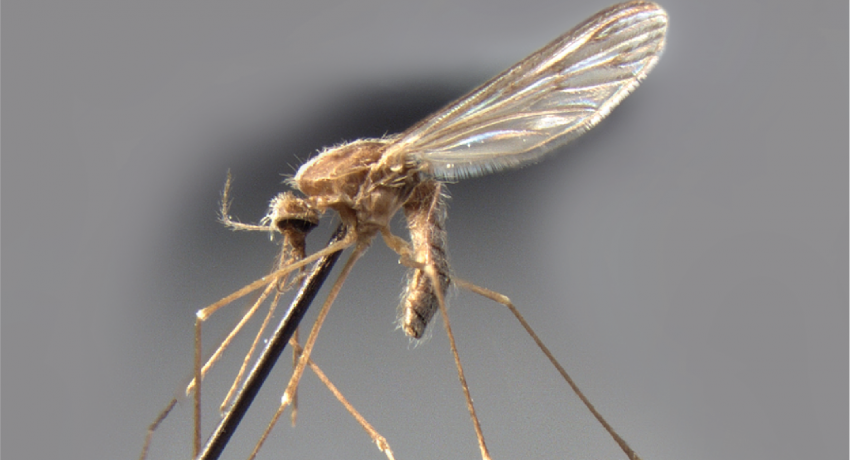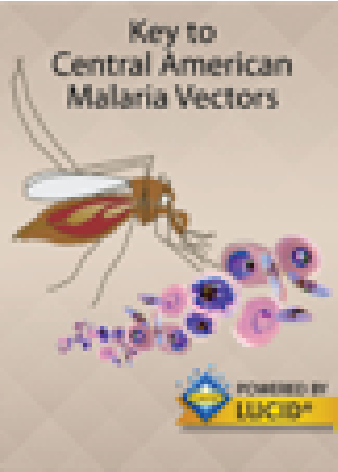NEARCTIC REGION
Etymology: Stanley Barron Freeborn
Anopheles freeborni is found in the western arid and semi-arid regions of the United States and Mexico, and up into Canada up to latitudes of under 48o. Together with An. earlei Vargas, An. hermsi Barr & Guptavanij, and An, occidentalis Dyar & Knab, An. freeborni belongs to the Freeborni Subgroup of the Holarctic Maculipennis Group (Anopheles Series; Angusticorn Section) of Anopheles subgenus Anopheles. Anopheles freeborni was originally described as a subspecies of An. maculipennis Meigen, based on specimens from Davis, California, United States, and was designated full species status two years later. The closely related An. hermsi is restricted to southwestern United States, where it often is found in sympatry with An. freeborni. The species are morphologically indistinguishable and the presence of An. hermsi was only confirmed following crossing experiments, and chromosomal and DNA studies. The species can be reliably differentiated using the internal (ITS) and external (ETS) transcribed spacer regions of the nuclear rDNA.
Type locality: Davis, California, United States
Type depository: California Academy of Sciences, San Francisco, California, United States (CAS)
DIAGNOSTIC CHARACTERS (Click photos to view; mouse over and click large photo to zoom in.)
ADULT (illustrated): Head: Scales and setae of interocular space (IS) and pale scales of vertex (V) yellowish white.Palpus unicolorous. Wing: Wing scales narrow, short and sparse, wing membrane readily visible on apical half of wing; wing entirely dark-scaled (including fringe at apex), with scales darker and / or more dense at crossveins and furcations, forming faint dark spots. Legs: Entirely dark.
LARVA (not illustrated): Head: Seta 1-A large, plumose; seta 2-C single, closely approximated; seta 3-C strongly branched (>25 branches); setae 5–7-C large, plumose. Abdominal segments: Seta 1-I,II very small or greatly reduced, not palmate; seta 2-IV,V usually 2–3 branched; seta 6-I–III plumose; leaflets of palmate seta 1-III–VII serrated.
TAXONOMIC KEYS
Pelaez 1945
Carpenter & LaCasse 1955
Wilkerson & Strickman 1990
Darsie & Ward 2005
![]()
WRBU - Anopheles – Central America
![]()
WRBU - Anopheles – Central America
![]()
WRBU - Genera - Global - Adult
![]()
WRBU - Genera - Global - Larva
![]()
WRBU - Genera - Nearctic - Adult
![]()
WRBU - Genera - Nearctic - Larva
![]()
WRBU - Genera - Neotropical - Adult
![]()
WRBU - Genera - Neotropical - Larva
Exemplar DNA sequences
An. freeborni COI: AF417717
BIONOMICS
Immatures
Immature An. freeborni are closely associated with rice agriculture, with highest densities found at the field margins, where the waters are warmer and algal growth is plentiful. Immatures are also found in other shallow ground pools of clear seepage water (e.g., roadside pools) in open sunlight and, much more rarely, in heavy shade.
Adults
Anopheles freeborni adults mate freely in confined spaces, allowing it to be easily colonized. As An. freeborni is a highly effective malaria vector, this species has become a valuable asset in controlled challenges to trial candidate vaccines. Female An. freeborni aggressively attack man and will enter houses to feed at dusk and through the night. On cloudy days, or in heavy shade, they are known to also bite during the day. In a rice agriculture system in northern California, over 99% of blood meals were mammalian, and only 3% were human, suggesting that An. freeborni feeds freely on animals in the absence of human hosts. In the Sacramento Valley, rabbits accounted for over 45% of bloodmeals. In northern parts of their range, adults will overwinter in diapause.
DISTRIBUTION NOTES
Canada, Mexico, United States (continental)

WRBU VECTOR HAZARD REPORTS
None; View other WRBU Vector Hazard Reports
Available GIS Models
None
IMPORTANT REFERENCES (full citations below)
Aitken 1939: 192 (M, F, E; as maculipennis ssp.)
King & Bradley 1941: 65 (to sp.)
Aitken 1945: 296 (M, F, P*, L*, E*; tax.)
Pelaez 1945: 74 (F*; key)
Penn 1949a: 55 (P*)
Ross & Roberts 1943: 7 (M*, F*, L*; distr., bion., as maculipennis freeborni)
Yamaguti & LaCasse 1950b: 25 (M*, F*, L*)
Pratt 1952: 484 (L*; tax.)
Belkin 1953a: 318 (P*, L*)
Rozeboom 1953: 677 (tax.)
Barr 1954: 445 (tax.)
Carpenter & LaCasse 1955: 39 (M*, F, L*; keys)
Horsfall 1955: 82 (review)
Kitzmiller & Baker 1963: 254 (chrom.*)
Dodge 1966: 362 (1st instar L*; key)
White 1978 (tax., review, keys, distr.)
Bohart & Washino 1978: 22 (M*, F*, L*; keys, tax., bion., distr.)
Porter & Collins 1996 (mol. phy. Nearctic)
Wilkerson & Strickman 1990 (F*; key);
Fritz et al. 1991 (mol. tax., chrom.)
Darsie & Ward 2005 (F*, L*; keys, distr.)
Sinka et al. 2010b (distr., bion.)
Sinka 2013 (distr., bion.)
CURRENT SYNONYMS
None
CITED REFERENCES
Aitken, T.H.G. (1939). The Anopheles maculipennis complex of western America (Diptera, Culicidae). The Pan-Pacific Entomologist, 15(4), 191–192.
Aitken, T.H.G. (1945). Studies on the anopheline complex of western America. University of California Publications in Entomology, 7(11), 273–354.
Barr, A. R. (1954). Hybridization of experiments with some American dark-winged anophelines. Experimental Parasitology, 3(5), 445–457.
Belkin, J.N. (1953a). Mosquitoes of the genus Uranotaenia in the Solomon Islands (Diptera: Culicidae). Pacific Science (Honolulu), 7, 312–391.
Bohart, R.M. & Washino, R.K. (1978). Mosquitoes of California (3rd ed.). Berkeley, CA: University of California, Agriculture and Natural Resources.
Carpenter, S.J., & LaCasse, W.J. (1955). Mosquitoes of North America (North of Mexico). Berkeley, Los Angeles: University of California Press.
Darsie Jr, R. F., & Ward, R. A. (2005). Identification and geographical distribution of the mosquitoes of North America, north of Mexico. University Press of Florida.
Dodge, H. R. (1966). Studies on mosquito larvae II. The first-stage larvae of North American Culicidae and of world Anophelinae. Canadian Entomologist, 98, 337–393.
Fritz, G.N., Dritz, D., Jensen, T., & Washino, R.K. (1991). Wing scale pattern variation in Anopheles punctipennis (Say). Mosquito Systematics, 23, 80–86.
Horsfall, W.R. (1955). Mosquitoes. Their bionomics and relation to disease. New York, NY: Hafner Publishing Company. (Reprinted 1972).
Kitzmiller, J.B., & Baker, R.H. (1963). The salivary chromosomes of Anopheles freeborni. Mosquito News, 23, 254–261.
Pelaez, D. (1945). Anofelinos de México. Clave para la determinación de especies y subespecies basada en los caracteres de las hembras adultas. Ciencia, 6, 69–77.
Porter, C.H., & Collins, F.H. (1996). Phylogeny of Nearctic members of the Anopheles maculipennis species group derived from the D2 variable region of 28S ribosomal RNA. Molecular Phylogenetics and Evolution, 6, 178–188.
Pratt, H.D. (1952). Notes on Anopheles earlei and other American species of the Anopheles maculipennis complex. American Journal of Tropical Medicine and Hygiene, 1, 484–493.
Ross, E. S., & Roberts, H. R. (1943). Mosquito Atlas. Part I. The Nearctic Anopheles, Important Malaria Vectors of the Americas and Aedes aegypti, Culex quinquefasciatus. Mosquito Atlas. Part I. The Nearctic Anopheles, Important Malaria Vectors of the Americas and Aedes aegypti, Culex quinquefasciatus.
Rozeboom, L.E. (1953). Sexual isolation in some North American Anopheles mosquitoes. American Journal of Tropical Medicine and Hygiene, 2, 677–682.
Sinka, M.E. (2013). Global distribution of the dominant vector species of malaria. In S. Manguin (Ed.), Anopheles mosquitoes - New insights into malaria vectors (pp. 109–143). Janeza Trdine 9, 51000 Rijeka, Croatia: InTech.
Sinka, M.E., Bangs, M.J., Manguin, S., Coetzee, M., Mbogo, C.M., Hemingway, J., ...Hay, S.I. (2010a). The dominant Anopheles vectors of human malaria in Africa, Europe and the Middle East: Occurrence, data, distribution maps and bionomic précis. Parasites & Vectors, 3(117), 1–34.
White, G.B. (1978). Systematic reappraisal of the Anopheles maculipennis complex. Mosquito Systematics, 10(1), 13–44.
Wilkerson, R.C., & Strickman, D. (1990). Illustrated key to the female anopheline mosquitoes of Central America and Mexico. Journal of the American Mosquito Control Association, 6, 7–34.
Yamaguti, S., & LaCasse, W.J. (1950b). Mosquito fauna of North America. Part I. Genus Anopheles. Office of the Surgeon, Hq. 8th Army.
CITE THIS PAGE
Walter Reed Biosystematics Unit (Year). Anopheles freeborni species page. Walter Reed Biosystematics Unit Website, http://wrbu.si.edu/vectorspecies/mosquitoes/freeborni, accessed on [date (e.g. 03 February 2020) when you last viewed the site].











































































































































































